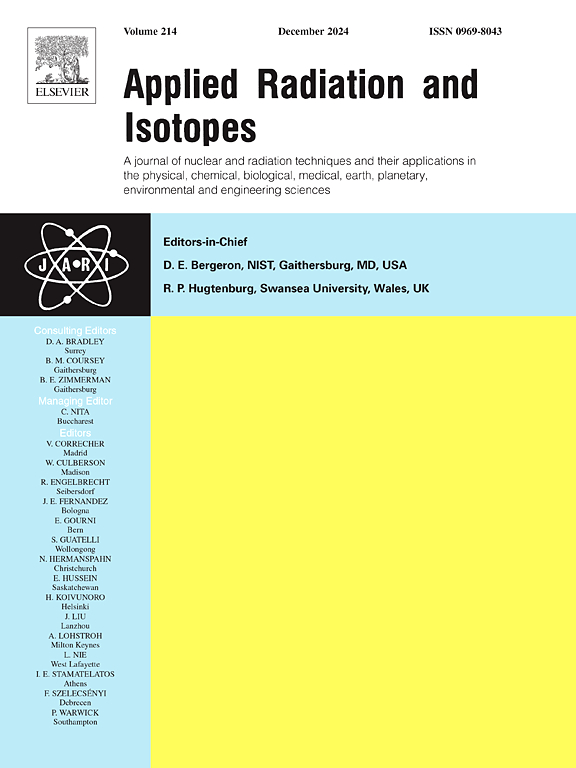Assessment of radioactive nuclides and heavy metals in soil and drink water in Lahij city, Yemen
IF 1.6
3区 工程技术
Q3 CHEMISTRY, INORGANIC & NUCLEAR
引用次数: 0
Abstract
This study was conducted in Lahij city, Yemen, to evaluate the concentrations and potential health risks of natural radioactive nuclides and heavy metals in soil and drinking water. A total of 21 soil samples and 17 water samples were collected from various locations. A high-purity germanium gamma detector HPGe was used to measure the concentrations of 40K, 232Th, and 226Ra in all samples, along with the concentrations of heavy metals. In soil samples, the average concentrations of 40K, 232Th, and 226Ra were 731.5, 30.7, and 28.16 Bq kg−1, respectively. While some samples showed higher than permissible levels for 226Ra and 232Th, the overall average remained within acceptable limits. However, 40K levels were almost twice the recommended global limits. In water samples, the average concentrations of these nuclides were 5.38, 0.73, and 0.66 Bq L−1, all within the global safety limits. Radiological risk assessments for soil indicated an average radium equivalent activity (Raeq) of 124.4 Bq kg−1, absorbed dose rate in air of 59.9 nGy h−1, annual effective dose rate of 0.07 mSv y−1, outdoor excess lifetime cancer risk (ELCR) of 0.26 × 10−3, and annual gonad equivalent dose (AGED) of 336.6 mSv y−1. Risk indices, including the activity concentration index (Iγ), external hazard index (Hex), and internal hazard index (Hin), averaged 0.48, 0.34, and 0.41, respectively, all below global limits except for AGED, which slightly exceeded the recommended level. For drinking water, the total ingestion dose was calculated for different age groups. The average doses for infants, children, and adults were 0.15, 0.27, and 0.19 mSv y−1, respectively. The doses for children and adults exceeded the permissible limits, while those for infants were within safe levels. Heavy metal concentrations were measured in all samples, and the Hazard Quotient (HQ) was calculated. In soil samples, HQ values for all metals >1, indicating potential health risks. In water samples, HQ values were also >1 for all metals except vanadium (V) and iron (Fe). To reduce the dangers associated with radioactive nuclides and heavy metals, regular monitoring and cleanup are crucial, and further research is needed to understand contamination sources and long-term health impacts.
评估也门拉希杰市土壤和饮用水中的放射性核素和重金属。
这项研究在也门拉希杰市进行,目的是评估土壤和饮用水中天然放射性核素和重金属的浓度及其潜在的健康风险。共从不同地点采集了 21 份土壤样本和 17 份水样。使用高纯锗伽马探测器 HPGe 测量了所有样本中 40K、232Th 和 226Ra 的浓度以及重金属的浓度。在土壤样本中,40K、232Th 和 226Ra 的平均浓度分别为 731.5、30.7 和 28.16 Bq kg-1。虽然有些样本中的 226Ra 和 232Th 含量高于允许值,但总体平均值仍在可接受范围内。不过,40K 的含量几乎是全球建议限值的两倍。在水样中,这些核素的平均浓度分别为 5.38、0.73 和 0.66 Bq L-1,均在全球安全限值之内。土壤辐射风险评估表明,平均镭当量活度(Raeq)为 124.4 Bq kg-1,空气吸收剂量率为 59.9 nGy h-1,年有效剂量率为 0.07 mSv y-1,室外超终生癌症风险(ELCR)为 0.26 × 10-3,年性腺当量剂量(AGED)为 336.6 mSv y-1。风险指数,包括活性浓度指数 (Iγ)、外部危害指数 (Hex) 和内部危害指数 (Hin),平均值分别为 0.48、0.34 和 0.41,除 AGED 略高于建议水平外,其余均低于全球限值。对于饮用水,计算了不同年龄组的总摄入剂量。婴儿、儿童和成人的平均剂量分别为 0.15、0.27 和 0.19 mSv y-1。儿童和成人的剂量超过了允许的限度,而婴儿的剂量则在安全范围之内。对所有样本中的重金属浓度进行了测量,并计算了危害商数(HQ)。在土壤样本中,所有金属的 HQ 值均大于 1,表明存在潜在的健康风险。在水样中,除钒(V)和铁(Fe)外,所有金属的 HQ 值也都大于 1。为了减少放射性核素和重金属带来的危害,定期监测和清理至关重要,同时还需要进一步研究,以了解污染源和对健康的长期影响。
本文章由计算机程序翻译,如有差异,请以英文原文为准。
求助全文
约1分钟内获得全文
求助全文
来源期刊

Applied Radiation and Isotopes
工程技术-核科学技术
CiteScore
3.00
自引率
12.50%
发文量
406
审稿时长
13.5 months
期刊介绍:
Applied Radiation and Isotopes provides a high quality medium for the publication of substantial, original and scientific and technological papers on the development and peaceful application of nuclear, radiation and radionuclide techniques in chemistry, physics, biochemistry, biology, medicine, security, engineering and in the earth, planetary and environmental sciences, all including dosimetry. Nuclear techniques are defined in the broadest sense and both experimental and theoretical papers are welcome. They include the development and use of α- and β-particles, X-rays and γ-rays, neutrons and other nuclear particles and radiations from all sources, including radionuclides, synchrotron sources, cyclotrons and reactors and from the natural environment.
The journal aims to publish papers with significance to an international audience, containing substantial novelty and scientific impact. The Editors reserve the rights to reject, with or without external review, papers that do not meet these criteria.
Papers dealing with radiation processing, i.e., where radiation is used to bring about a biological, chemical or physical change in a material, should be directed to our sister journal Radiation Physics and Chemistry.
 求助内容:
求助内容: 应助结果提醒方式:
应助结果提醒方式:


